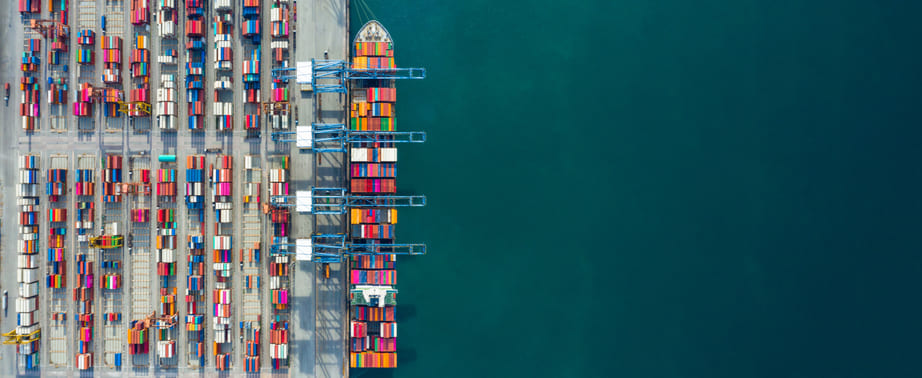The ancient innovations that led to our modern wine transportation systems
Today, wine can be transported all around the world from thousands of miles away. But this ancient industry has some unique problems that it has had to solve to transport wine from vine to glass. Some of which are still a challenge today. So how did we move from amphorae to bottles to flexitanks? Let’s take a look…
How was wine transported in ancient times?
From the Neolithic period, wine was the answer to contaminated water as populations began to form settled farming communities. The earliest proof of wine making comes from the Zagros mountains, in what is now Iran, around 5400 - 5000 B.C.
Wine was used to decontaminate water, as an antiseptic, social drink and trade commodity. Watered down wine became a staple drink, right up until Roman times and beyond. This meant wine needed to be transported long distances from where it was made. So how has wine transportation evolved from these age-old roots?
Clay jars and amphorae
It’s thought that the first wine was carried in animal skins, but that these did not survive in the archaeological record. The first evidence of wine transportation comes from clay jars and amphorae, which are large, slender clay vessels with long necks to reduce the amount of wine in contact with oxygen in the air. As we know, oxygen can ruin the taste, aroma and even color of wine. Amphorae were invented by the Egyptians, and used for wine transportation and storage for over 5500 years.
Roman wine logistics
Wine's inherent usefulness meant that when the Roman army marched north, they needed new ways to transport the huge quantities of wine that the soldiers required. The Romans developed a wine ‘logistics’ system to make wine transportation as efficient as possible.
They tweaked the design of amphorae over hundreds of years, to reduce weight without sacrificing strength. The goal was to squeeze ever more amphorae into the cargo holds of ships, with as few breakages as possible. Alongside amphorae, the Romans also used a much larger jar called a dolium for storage and mass transport, which held around 1300 L of wine each. Clay vessels were essential for wine transportation for a long time, until suddenly, they disappeared.
The switch to wooden barrels
The sea has always been vital to wine transportation, but as the Roman army conquered areas far inland, a new solution was needed. Luckily for the Romans, clay vessels weren’t the only wine transportation technology that existed at the time. As the Roman army moved north, they encountered the Gauls who transported beer in wooden barrels. Julius Caesar invaded Gaul in 58 B.C. After this, the Romans rapidly switched from amphorae to wooden barrels as their preferred wine transportation medium. By the beginning of the 5th century, amphorae were no longer produced.
It’s easy to see why. Wooden barrels are stronger than clay, weigh less and can be rolled from one spot to another. This meant that wine could be transported over rough ground and bumpy roads without breaking. Wine could now be easily transported over land.
Christian church gains political power
In the early Middle Ages, wine transportation innovation stalled. After the fall of Rome, the Christian Church had significant political power. Although wine was still made, the Church did not allow much technological innovation. The basic technology used, crushing grapes by foot in the open air and storing it in wooden barrels, meant that wine could only be stored for a few months at most, compared to the decades achieved by the earlier Egyptians and Romans with amphorae. Long distance wine transportation became harder.
Cistercians arrive in 11th Century in Burgundy
After the 600-year lull in wine transportation and production innovation in Europe, things began to change once again in the 11th Century. The Cistercians, a Catholic religious order, arrived in Burgundy in the late 11th century. They knew that wine barrels needed to be kept full and that it was best to store them underground to protect it from temperature fluctuations. The first large wine cellars, a precursor in some ways to modern wine warehousing, were built in this period. By the 12th Century, trade between Bordeaux and England was booming.
Glass bottles transform wine transportation
In the 17th Century, glass bottles thick and strong enough to be transported on bumpy roads were invented. Wine bottles were more convenient to carry, and protected wine from oxidation in a way that porous wooden barrels couldn’t.
Intermodal steel containers catch on
In the 1950s, wine was transported in containers of all shapes and sizes. These had the advantage of being strong, large and non-porous. A cargo ship was loaded with crates containing a variety of products, from fruit to drums of solvents. Dockworkers needed to load as many items into the ship as quickly as possible, to maximise profits, but they also needed to distribute the cargo’s weight evenly to prevent the ship capsizing in rough seas. As the loading was done manually, loading and unloading cargo was slow, dangerous, backbreaking work.
An intermodal transport system, where standardised containers that could be carried by trucks, trains and ships, was trialed in the US in the 50’s. Intermodal containers meant that cargo could be loaded into its container at the start of its journey and unpacked only when it reached its final destination. By 1956, the first modern container ship was fully loaded by a crane in under 8 hours.
Standardised shipping containers
Just five years after the first modern container ship sailing, a standard international container size ‘20-foot-equivalent container unit’ (TEU), was agreed, and is still the standard today. Containers could now stack neatly together using all the space available. By the end of the 1960s, container ships were carrying 1,000 TEU intermodal containers between the continents.
Hillebrand Gori’s wine transportation history
The Hillebrand Gori of today is the result of the merging of Hillebrand’s expertise in global logistics of beverages, namely wine, beer and spirits, with DHL owned wine forwarders Gori. Here’s a brief chronological look at our combined history:
- Hillebrand has played a role in wine transportation, not quite since ancient times, but since their founding in 1844.
- Beginning with wine transportation services to Berlin, Dresden and Leipzig, Hillebrand went on to expand overseas to the USA. By 1875, the company already offered a complete logistic service, covering road, rail, river-barge and maritime shipping.
- In 1957, Hillebrand was rebuilding shipping services after World War II for the wine industry to Britain, and later to the USA and Canada.
- Gori was founded in 1947, specialising in wine and spirits transportation.
- From 1962 Gori evolved to become a go-to forwarder in Italy and surrounding areas for the wine and spirits market.
- Around the same time and in the years that followed, Hillebrand expanded into France and then imported from other European countries, such as Spain, Italy, Portugal as well as Scotland.
- In 2014 Gori became fully owned by DPDHL, under the DHL Global Forwarding division.
- The J.F. Hillebrand group came together with DHL subsidiary Gori after being bought by DHL in 2022 to create a powerhouse service provider for the international wine, beer, spirits industries.
How is wine transported around the world today?
Wine transportation has challenges that are ancient, as well as newer ones. The age old challenge for wine transport is how to move it without spoiling its quality or breaking the receptacle holding the liquid. Bottles used to transport wine today are strong, lightweight and uniform in size. They pack neatly into cases, which stack on pallets, which load perfectly into containers. Wine transport today is also intermodal, with a supply chain made up of trucks, freight trains and cargo ships to carry the wine for different legs of its journey.
ISO tanks
ISO tank containers are large steel tanks used mainly for spirits transportation. The ABV of spirits means large volumes are classed as dangerous goods and so ISO tanks are the only way to move them. They can carry many other liquids too, even wine. The temperature inside an ISO tank remains stable throughout transport, since they are made from steel with an inbuilt insulation.
Bottles
Glass bottles still dominate much of global wine transportation. They can be shipped inside containers, with multiple pallets filling the whole of the container (called a Full Container Load service), or a few pallets included as part of a Less than Container Load.
Flexitanks
For over 5500 years, clay vessels were used for wine transportation. Next, wood was used exclusively for 1200 years. Around the late 2000’s, bulk wine transportation was transformed again, by new flexible plastic tanks, called Flexitanks. These new tanks were light yet strong, solving an age-old problem.
Today, flexitanks can carry more than double the wine volume of a standard 20ft container, cutting wine transportation per liter costs dramatically. Per liter, flexitanks also have a lower carbon footprint than wine bottles , and their size means that their contents are better protected from temperature changes than wine in individual bottles. They are 100% recyclable too: at Hillebrand Gori we recover and recycle empty flexitanks as part of our circular economy efforts. You can find out more about this history of modern container transport here.
How can we help solve your modern day wine transportation challenges?
Thanks to globalisation, wines from different places are available almost anywhere in the world. Choosing a specialist wine transportation partner like Hillebrand Gori, that has been shipping wine for almost 180 years will ensure your wine reaches its destination quickly and safely, using the transportation method that fits your needs.
Hillebrand Gori can help you protect the quality of your wine by predicting the temperature en route, and offer you the best possible solution to protect your wine against thermal shock, either with an exclusive insulation liner or a refrigerated container. We have offices everywhere where wine is crafted or consumed, with local experts who can help you navigate the legislation and customs that come with modern wine transportation.
Published 7th June 2023, updated 26th March 2024
Transporting wine is a niche sector within the logistics industry. It involves moving wine from where it is made to where it is consumed. This can involve various modes of transportation, such as trucks, trains, ships, or planes.
Flexitanks and ISO tanks are two options for shipping wine in bulk. Flexitanks are more accessible and can be recycled. ISO tanks require cleaning after each use and can be harder to come by in the market.
Bulk transport refers to moving large quantities of wine in bulk containers such as flexitanks or ISO tanks, whereas bottled transport refers to shipping wine in cases on pallets. Bulk transport is generally more cost-effective per liter, while bottled transport allows you to ship more than one type or brand of wine in a single container.
Insulated containers offer protection against temperature fluctuations, which can impact the quality and taste of wine. With insulated containers, you’ll have a stable climate throughout the journey, preventing thermal shock and preserving the integrity of the wine.
How can we help your business grow?

.png?sfvrsn=fc4f657e_1)



